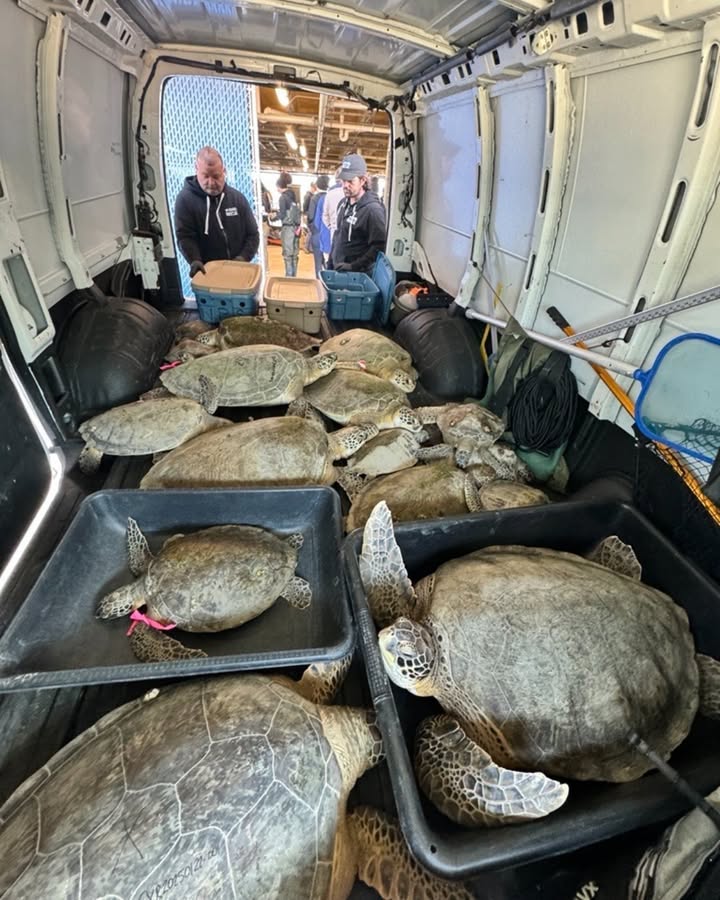- Understanding cold-stunning in sea turtles and its impact on their health.
- The critical role of wildlife centers in sea turtle rescue and rehabilitation.
- Collaborative efforts in sea turtle conservation and community involvement.
- Rehabilitation strategies and techniques used for cold-stunned sea turtles.
- Long-term conservation goals and the release of rehabilitated turtles back into the wild.
Sea turtles, ancient mariners of our oceans, face numerous challenges due to natural and human-induced factors. One such challenge is cold-stunning—a condition that affects sea turtles when water temperatures drop suddenly. On Wednesday, January 22, 2025, 405 cold-stunned sea turtles were admitted to our Center for Wildlife Rescue. This event underscores the urgent need for wildlife rescue teams and reflects the complexity of caring for these reptiles. It requires swift action and collaboration among scientists, conservationists, and local communities.
Cold-stunning is a phenomenon where turtles, being ectothermic animals, experience a dramatic decrease in body temperature when exposed to cold water for prolonged periods. This condition impairs their ability to swim, eat, and escape predators, often rendering them immobile or washing them ashore. Immediate intervention is crucial to prevent further complications, such as pneumonia or infections, which can occur due to their weakened state. Our Wildlife Rescue Center is a key player in managing such crises, offering a haven where affected turtles can receive medical attention and recuperation.
Wildlife rescue and rehabilitation centers play a pivotal role in the survival and recovery of cold-stunned sea turtles. These facilities are equipped with veterinary expertise, medical supplies, and devoted staff to address the complex needs of stranded turtles. Upon arrival, each turtle undergoes a thorough health assessment, including blood work and physical examinations. Once stabilized, they enter a controlled environment where their body temperature can gradually return to normal levels. This process is meticulous but essential to ensure the well-being of these vulnerable creatures.
The successful intake and care of 405 turtles highlight the indispensable role of community collaboration in wildlife conservation. Volunteers, local authorities, and everyday citizens are vital in reporting stranded turtles and assisting with transportation to rescue centers. Many individuals spend hours patrolling beaches during cold spells, showcasing the profound impact of collective efforts in conservation efforts. By fostering a sense of shared responsibility, communities become actively engaged in preserving their natural heritage, supporting broader conservation outcomes.
In the rehabilitation of cold-stunned sea turtles, various strategies are employed to expedite the recovery process. Gradual rewarming is vital to avoid shock. This is followed by intensive care, including fluid therapy to address dehydration and supplementary feeding when turtles resume eating. The rehabilitation period may last several weeks, during which turtles regain strength and, importantly, their natural behaviors. Preparing turtles for release involves not only health recovery but also ensuring they are physiologically ready to navigate their environment again.
The ultimate goal of rescuing and rehabilitating cold-stunned turtles is to reintegrate them into their natural habitats. This step is executed with precision, often involving satellite tagging to monitor their post-release movements and survival. Long-term conservation strategies focus on habitat preservation, reducing bycatch, and mitigating climate change—factors that contribute to such wildlife emergencies. Through data collection and research, scientists can better understand and anticipate conditions that lead to mass cold-stunning events, thereby enhancing future intervention strategies.
Cold-stunning incidents, such as the recent admission of 405 turtles, emphasize the urgent need for continued support and innovation in wildlife conservation. Utilizing a mix of science, community involvement, and dedicated resources enables our Center for Wildlife Rescue to address such challenges effectively and provide these ancient navigators with a fighting chance for survival. Protecting sea turtles requires interdisciplinary strategies and a collective commitment, illustrating that it indeed takes a village to make a significant impact in wildlife conservation efforts.
*****
Source Description
Sea turtle update! On Wednesday, January 22, 2025, we admitted 405 cold-stunned sea turtles to our Center for Wildlife Rescue.
It truly takes a village to protect and care for our wildlife. A huge THANK YOU to everyone who has been reporting stranded turtles, patrolling the beaches, and helping transport them to our Center for Wildlife Rescue. Over the last few days, we received multiple groups of cold-stunned sea turtles, and our team is working tirelessly to warm them up, rehabilitate them, and prepare them for release back into their natural habitat to as many as we can. Thank you for your support!🐢💙


